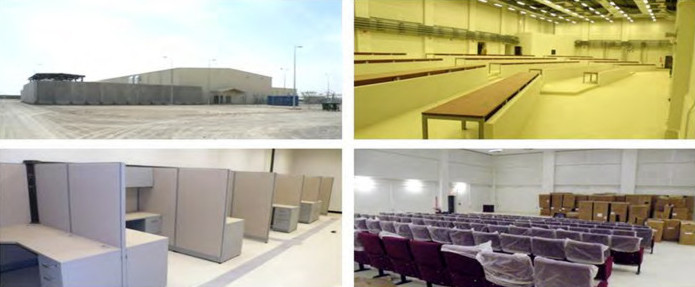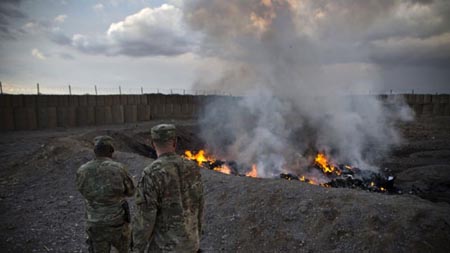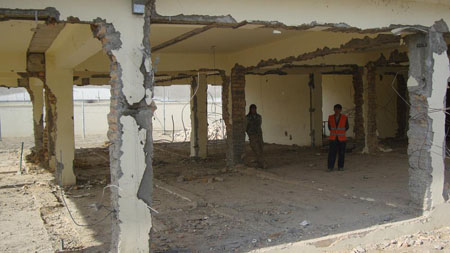By Alice Speri
You might have heard that the US spent some $102 billion trying to develop Afghanistan over the last decade — and that’s in addition to the estimated $6 trillion it spent going to war there in the first place.
You also might have heard that a lot of that money vanished into thin air, went to shady contractors, corrupt politicians, or, occasionally, the Taliban.
But if you thought that getting out of Afghanistan would save us some cash, you’re wrong. The troops might withdraw, if things go as planned, by the end of the year, but US dollars are going to have to keep flowing into the country for years to come to keep it afloat. If things go bad, the US might feel compelled to start the war all over again.
As VICE reported in its recent HBO documentary “Afghan Money Pit,” monitoring the billions in aid has been a huge challenge so far. And with the security situation in the country taking a sharp turn for the worse, that’s about to get a lot harder.
“Our concern is that as we continue with the drawdown, it’s going to be more difficult to manage and oversee the billions of dollars of programs that we’ll continue to do. It’s going to be harder, and it’s going to be more expensive,” John Sopko, the Special Inspector General for Afghanistan Reconstruction (SIGAR), told VICE News.
Sopko will testify about wasteful spending in Afghanistan before a Congress subcommittee on Thursday.
“What you need is to look at how much money it is going to cost to monitor those programs and then sit back and say, well, is it worth spending, for example, $1 million on monitoring a $500,000 program? Maybe you want to look at some of the programs you’re doing and not do them because it’s not cost effective. But there may be some programs you still have to do.”
Follow the money?
Both executing and monitoring development projects is going to be tough with no troops on the ground, as SIGAR expects less than 21 percent of Afghanistan to be accessible to US civilian employees by the end of the year. Military officials also said they won’t allow civilians to travel anywhere further than 30 minutes away from advanced medical facilities.
“If the government, the judiciary, the police that are supposed to deal with it are themselves corrupt, where do you turn?” Nanayakkara added. “Maybe you take up arms and fight. We need to see that connection.”
If the plan is to follow the money, this doesn’t bode too well.
That at least is the concern of the US Agency for International Development (USAID), which has put some $14.4 billion towards the country’s reconstruction, and which earlier this month opened a call for bids on a new monitoring project contract — making up for a lack of access through technology.
The agency hopes to step up its use of smartphones, satellite imagery, and GPS cameras to oversee tax-funded programs it won’t be able to access once the troops are gone.
“The American people have been very generous in pursuit of our national security objectives in Afghanistan, and we’re absolutely intent on making sure that that funding is used as effectively and as accountably as possible,” Kathleen Campbell, USAID’s Deputy Assistant to the Administrator in the Office of Afghanistan and Pakistan Affairs, told VICE News. “If we don’t have the monitoring and oversight that we want, if we’re not comfortable with our access, with our sources, with what we’re hearing, or if we’re not able to get enough data, then we’ll close the project down.”
Campbell, who said the agency made “huge progress” in Afghanistan, said that technological oversight has already proved that it works, and that it is worth the cost.
“When somebody goes and visits the project they can bring a camera, which is GPS and time-stamped, they can use mobile technology to upload data,” she said, explaining that the agency will tap local government, civil society, and sub-contractors to help in a “multi-tiered” approach to oversight.
“Telecommunication has been a huge success story in Afghanistan. Around 80 percent of the population is covered by mobile networks,” she added. “You can reach a lot of people, and you can set up very simple feedback mechanisms where they report on whether they’ve received their salaries, for instance, or whether the teacher showed up at school.”
SIGAR is yet to review this contract, which will cost about $170 million, but Sopko suggested it is not much different from what USAID already does now, and questioned the additional cost. Critics of the project also said the long-distance monitoring plans are both long overdue and “no substitute for going there.”
“If you’re at the point where that’s one of your only sources of evaluation, you really have to ask the question whether or not you should be doing it in the first place,” Ashley Jackson, a researcher with the Overseas Development Institute's Humanitarian Policy Group who spent years working on aid effectiveness in Afghanistan, told VICE News. “The further you put yourself away from your project, the greater the risk of fraud. And it doesn’t really matter if you have GPS or satellite technology.”
Did we spend too much money in Afghanistan?
Jackson criticized donor agencies and larger NGOs for repeatedly employing contractors with “atrocious track records,” for spending too much money, and for not seeking the input of the local population. The battle to buy the hearts and minds of the Afghan people through development projects, she added, was “naive.”
“You can’t buy off the Afghan population by paving a road,” she said. “We tend to think of people who receive aid as passive victims who are so grateful for our support, but if you have a western government coming into your country saying ‘This is how you should do things,’ you’re going to take your piece and exploit it, you’re going to be active in that process.”
The projects that did work in Afghanistan were small-scale and long-term, Jackson said.
“The question wasn’t asked, ‘What do people need, what’s going to be sustainable?’ It was, ‘We have a lot of money to burn,'” she explained. “You don’t need to spend that much money to have an impact, you just need to spend it well. It’s not rocket science.”
And yes — too much money, in a country as poor as Afghanistan, can spell big trouble.

Photos depict scenes at the $34 million command center in Camp Leatherneck, completed in November. U.S. troops will never use the facility, the Special Inspector General for Afghanistan Reconstruction says. (Photo: SIGAR)
“Pouring too much money, too fast, with little oversight, is a recipe for disaster. You totally distort the local economy, you throw so much money that of course there’s going to be corruption” Sopko said. “How do we make certain that the money we’re giving is not stolen, is not poorly spent, is not going to support hotels and condominiums in Dubai?”
The funds flowing to Afghanistan were not matched by a proper strategy to keep them in check, critics said, so often did more damage than good.
“The system itself is in a way geared towards not addressing some of these really hard issues,” Sopko said, citing the short tours of duty of most US workers in Afghanistan. “If you’re only there for nine months, by the time you make a big deal over some corrupt official you’re gone. If you spend all your time fighting with the local corrupt boss or not giving money to the local warlord, you have nothing for your annual performance review.”
Multi-million dollar projects leak money on all sides.
This is how it usually goes. First, donor agencies contract work out to “implementing partners,” who then also contract them out, several times over, often eventually tasking construction to businesses with ties to Afghanistan’s ruling elite — including the Karzai family, who have faced persistent accusations of corruption. Then, when what’s left of the money hits the ground, payments have to go out to local officials, police, and, increasingly, the Taliban themselves.
“By structure, international aid has created something that allows the money to go to the Taliban, to the police, to whoever is corrupt and is asking for money,” Yama Torabi, director of the local watchdog Integrity Watch Afghanistan, told VICE News in a 2013 interview.
But what the Taliban may get out of the deal is nothing in comparison to what Afghanistan’s elites make, and foreign contractors received before them — Torabi’s group estimates that 80 percent of foreign aid goes to someone outside Afghanistan.
“Instead of doing small contracts, like $1 million, they will do something like $500 million, and that will go to a company that’s going to sub-contract to other companies, and those companies will sub-contract to others,” he said. “You lose accountability when you do sub-contracting.”
That’s how a foreign-funded police station that shouldn’t have cost more than $200,000 ended up with a price tag of more than $2 million.
“I was shocked to see this price, because it can’t be,” Torabi said. “It’s ten times more than what it should be in this country. That’s really, really huge.”
Aid agencies claim they have learned that lesson. According to Campbell, USAID said that it has adapted its subcontracting practices “so we have more direction with the partner.”
Ghost workers and broken dam dreamsMore than a decade in — billions of dollars, poor oversight, and massive corruption have translated into a pretty colossal waste of money.

Feb. 4, 2013: U.S. Army soldiers watch garbage burn in a burn pit at Forward Operating Base Azzizulah in Maiwand District. Soldiers at FOB Sharana had to use a similar burn pit because 5.4 million USD incinerators were not completed. (Photo: Reuters)
The list of disastrous projects is long and depressing, but highlights include a dam the US has been trying to complete since the 1950s — at a cost of tens of millions of dollars and scores of coalition lives — and a never-used $34-million military facility in Helmand Province that the army had to either tear down or turn over to the Afghans. They handed it over, but for some reason the building will need a “major overhaul” before Afghanistan's government can use it, so the military signed an additional $1.2 million check for the Afghans to finish the work, before saying that it won’t stick around to see what happens to it.
“It is kind of reflective of an attitude that once the facility has been transferred to the Afghans, even if we’re giving them a check for $1.2 million to finish it, we’re washing our hands of it,” Sopko said. “That could be a million down the drain, and if you multiply that by hundreds of bases, you’re talking big bucks.”
SIGAR said today that a $11.3-million prison in Baghlan, built with a Department of State contract, shows “serious structural damage” and endangers staff and prisoners because it is located in one of the country’s most earthquake-prone areas.
To make matters even worse, reports also recently emerged of “ghost workers” in the Afghan National Police — also known as fully salaried members of the force that just happen to not really exist. This is bad, not just because it’s a lot of money going who knows where, but also because if you’re trying to secure one of the most dangerous countries in the world, having a proper count of the cops available might be a good idea.
Jackson said that on a recent visit to a part of Nangarhar district “basically encircled by the Taliban,” an official told her there were only 20 policemen in the local force. “But there were 150 on the official rolls,” Jackson added.
The European Anti-Fraud Office told VICE News that it put EU funds “on hold” after conducting an investigation. SIGAR claimed this included about half of its €200 million ($275 million) contribution to LOFTA. But a spokeswoman for the European commission for development (DEVCO) told VICE News that “the existence of ghost workers was not confirmed.”
The concern, however, is serious enough that the US military — which pointed to previous issues with personnel records not matching payrolls at the Afghan Ministry of Interior, and already fixed 54,000 “erroneous personnel” data in the LOFTA database —started its own review of the issue.
Whose fault is corruption anyway?
Ask anyone working there, and they’ll tell you that Afghanistan is one of the most corrupt countries in the world — regularly making Transparency International’s top three (currently up there with Somalia and North Korea, if you’re wondering.)
But ask people whose responsibility it should be to tackle corruption — or how – and things get more complicated.
“We have always given lip service to fighting corruption but we just didn’t put our heart into it,” Sopko told VICE News. “We put conditions but we never really enforced those conditions. Maybe we’re afraid to say no, we are afraid of the Afghans calling our bluff.”
But Rukshana Nanayakkara, Transparency International’s Regional Outreach Manager for Asia Pacific, thinks the burden should fall on the Afghan government itself and expressed hope that whoever wins Saturday’s presidential vote will be more serious about the issue than the current government.
“If you want to eradicate corruption, you cannot say the international community should do it. The main duty should be with the government because they are the trustees of the people,” he told VICE News. “Unfortunately, so far they have not shown the political will to do so.”
Nanayakkara said donors should put more pressure on local politicians and focus on smaller scale projects to reduce risk. But he also said everyone needs to take corruption more seriously, and added that the lack of institutional credibility risks legitimizing the insurgency.
“People think corruption is bad, but they don’t really see the impact of it as, for instance, with human rights abuses. So we don’t act very fast when it comes to corruption,” he said. “But in the long run corruption has very adverse effects on the lives of people.”
“If the government, the judiciary, the police that are supposed to deal with it are themselves corrupt, where do you turn?” Nanayakkara added. “Maybe you take up arms and fight. We need to see that connection.”
Fueling the country’s corruption is not gaining foreigners in Afghanistan any sympathy.
“We are trying to win over people to support the central government, and if the central government is totally corrupt, we’re not winning over the local people,” Sopko said.

A $11.3-million prison, built with a Department of State contract, shows “serious structural damage” and is located in one of Afghanistan’s most earthquake-prone areas. (Photo: SIGAR)
“If you want to know what’s happening, you have to basically do a screening of the Afghan political elite and see how many of the big families are into this big contracting business with the internationals,” Torabi said. “Indirectly or indirectly, the international community is paying for the Afghan political elite and sustaining corruption.”
But Nanayakkara warned against withholding support just because corruption can’t be stopped.
“Donors should not withdraw from a country just because we are not in a situation to tackle corruption,” he said. “It’s too late, but we can’t say we’ll withdraw because it’s too late. We cannot isolate the people of Afghanistan just because it’s difficult.”
Lesson learned (or have we?)
On that, at least, everyone seems to agree. Non-involvement in Afghanistan is not really an option.
Even those calling for much less money to be spent — and wasted — in the country, fear that the impact will be felt largely by the more successful programs, including those focusing on health, education, and women.
“If the US stops giving money to Afghanistan, the general consensus is that it will devolve into a civil war,” VICE’s Shane Smith said. “If we give them money and it’s being thrown down the toilet, or warlords are taking it, that’s another problem… If you cut off all the money, then it’s over.”
Afghanistan may now be a catch-22, but US donors have missed several chances to learn a lesson. Sopko pointed to a 1988 USAID report on development in Afghanistan, drawing many of the same conclusions that US officials are realizing now. And many of the mistakes made in Iraq — particularly with sub-contractors — were repeated in Afghanistan and are once again becoming the norm.
“I’ve seen it in Somalia, in Yemen. The system of corruption and collusion between the US government and these contractors was born in Afghanistan and is being replicated elsewhere,” Jackson said, adding that development in Afghanistan took a turn for the worse after a surge both in military presence and in misguided development projects. “In 2010 you had this massive influx of money and all these quick-impact projects, and focus on burn rates rather than results.”
“That’s very important for understanding why Afghanistan is such a mess now,” she added. “If you look back, it could have gone differently.”



